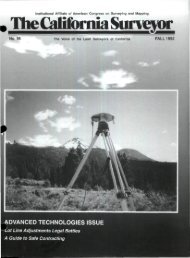P - CLSA
P - CLSA
P - CLSA
You also want an ePaper? Increase the reach of your titles
YUMPU automatically turns print PDFs into web optimized ePapers that Google loves.
p<br />
p<br />
Varied Forces<br />
Affect Surveying on the Surface<br />
Reprint from Texas Surveyor<br />
NovJDec. 1985<br />
by David Moore, RPS 2040<br />
NOTE: The following is not written<br />
as a treatis on geodetic science but<br />
to familiarize surveyors with the<br />
forces, concepts and relationships<br />
that exist in the physical and<br />
mathematical conditions that affect<br />
surveying results.<br />
The surveyor, his surveying, and<br />
his resulting data, are directly affected<br />
by certain forces and conditions<br />
that in most cases are not<br />
physically evident and may be<br />
changed by varying the conditions<br />
mathematically. Each of these<br />
forces and conditions may be<br />
visuahzed as a surface and then expressed<br />
in numerical terms.<br />
The obvious surface is that of the<br />
earth or some part thereof, upon, or<br />
near, where we actually make our<br />
measurements. This topographic<br />
surface controls location of the<br />
survey lines and the slope of the<br />
lines of sight, but in and of itself,<br />
and other than in slope, has little<br />
physical affect on the<br />
measurements.<br />
The surface with the greatest<br />
physical affect on the<br />
measurements is that of gravity.<br />
Although we seldom consider gravity<br />
as having a surface, such a concept<br />
allows us to visualize a surface<br />
in which the force of gravity is the<br />
same at all points on that surface —<br />
an equipotential surface. The<br />
equipotential surface which has<br />
been adopted for the earth is called<br />
the geoid.<br />
Of course we can adopt various<br />
potentials and each will be of a different<br />
size, but they will have the<br />
same shape. Because of the mixed<br />
density of the earth, the geoid is not<br />
uniform in shape. The surface undulates,<br />
and one might look at it as<br />
a potato.<br />
Another visualization would be to<br />
cut friction-free channels across the<br />
land masses and fill them with<br />
water, so as not to dimish the<br />
volume in the oceans. Then, having<br />
eliminated the effects of wind, air<br />
pressure, and luni-solar tides, the<br />
resulting water surface would be the<br />
surface of the geoid.<br />
At each point there is a line<br />
perpendicular to the geoidal surface,<br />
called the vertical or the direction of<br />
the force of gravity; and it is the vertical<br />
to which the axis of a survey instrument<br />
is oriented.<br />
Because the geoid is non-uniform<br />
in shape and its surface has no<br />
uniformly variable distance from<br />
The surface with<br />
the greatest<br />
physical affect on<br />
the measurements is<br />
that of gravity.<br />
Tangent Cylinder<br />
>./- -+-;-^l<br />
Figure 1<br />
some fixed point, it offers a very<br />
undesirable surface upon which to<br />
compute.<br />
Another surface, one that is mathematically<br />
expressable, therefore, is<br />
substituted. This surface is usually<br />
an oblate eUipsoid revolved on its<br />
minor axis to provide a soHd form.<br />
(Continued on page 25)<br />
Tangent Cone<br />
The California Surveyor — Summer, 1986 Page 23
















